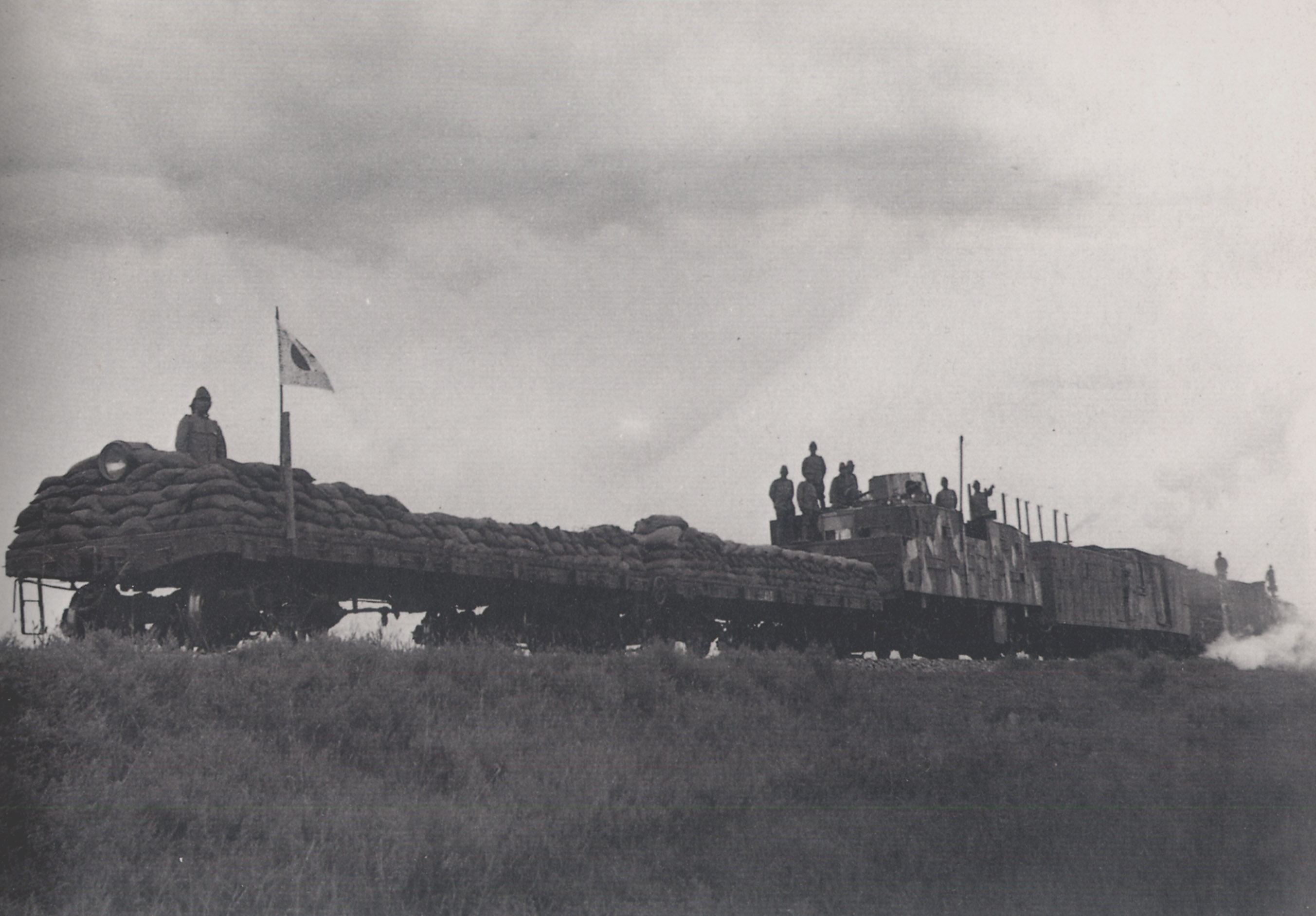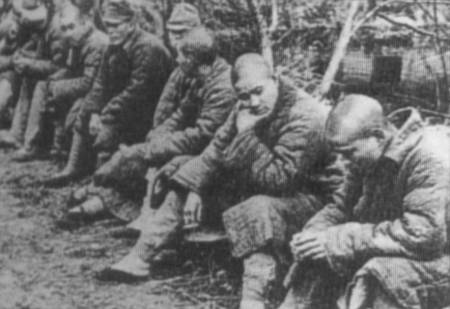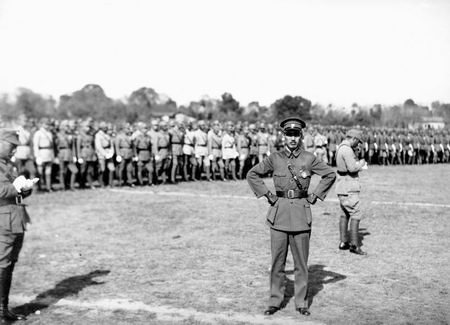|
Sun Lianzhong
Sun Lianzhong (; 2 February 1893 – 14 August 1990) was a Chinese general during the Warlord Era, Second Sino-Japanese War and Chinese Civil War. Best known for his command of the 2nd Group Army in the Battle of Taierzhuang, he had a long career in the army. Biography Sun enlisted in the army in 1912. During the Warlord Era he was a member of the Northwest Army led by Feng Yuxiang. During the Northern Expedition he fought with Zhang Zuolin's Fengtian Clique, and fought with Feng and Yan Xishan against Chiang Kai-shek in the Central Plains War. He eventually rejoined the Nanjing government, and commanded Nationalist forces during the 2nd, 3rd and 5th Campaigns against the Jiangxi Soviet. During the Second Sino-Japanese War he commanded the 1st Army in the Northern Peiking – Hankow Railway Operation, and the 2nd Group Army in the Battle of Taiyuan and the Battle of Xuzhou. As Deputy commander of the 6th war Area he was in command of the Chinese forces during the Battle o ... [...More Info...] [...Related Items...] OR: [Wikipedia] [Google] [Baidu] |
Sun (surname)
Sun () is a transliteration of a common Chinese surname (; pronounced ). It is the third name listed in the Song dynasty Chinese classics, classic text ''Hundred Family Surnames''. Other transliterations include Suen (Hong Kong and regions with Cantonese-speaking populations), Soon (Amoy dialect), Sng and Soon (Teochew dialect), Tôn (Vietnamese language, Vietnamese), Son (Korean surname), Son (Japanese language, Japanese/Korean language, Korean), Soon (regions with Hokkien-speaking populations), Sen/Suan/-son/-zon (Chinese Filipino in the Philippines), and Swen. In 2019, Sun was the twelfth most common surname in mainland China. A 2013 study found it to be the 12th most common name as well, shared by 18,300,000 people or 1.38% of the population, with the province with the most being Shandong. Note that in Hong Kong and regions with Cantonese-speaking populations, the surname Xin (surname), Xin (辛) is also transliterated as Sun. Origins *The name Sunshu Ao (孫叔敖) comes ... [...More Info...] [...Related Items...] OR: [Wikipedia] [Google] [Baidu] |
Battle Of Taierzhuang
The Battle of Taierzhuang ( zh, t=, p=Tái'érzhuāng Huìzhàn) took place during the Second Sino-Japanese War in 1938. It was fought between the armies of the Republic of China and the Empire of Japan in the peak of the Xuzhou Campaign. The battle was the war's first major Chinese victory. It humiliated the Japanese military and its reputation as an invincible force; for the Chinese, it represented a tremendous morale boost. The battle was characterized by vicious close quarters combat. The cramped conditions of urban warfare Urban warfare is warfare in urban areas such as towns and cities. Urban combat differs from combat in the open at both Military operation, operational and the Military tactics, tactical levels. Complicating factors in urban warfare include the p ... neutralized Japanese advantages in cannon and heavy artillery. In these circumstances, the Chinese were able to fight the Japanese as equals. Unlike previous engagements, the Chinese managed to resupply the ... [...More Info...] [...Related Items...] OR: [Wikipedia] [Google] [Baidu] |
Beijing
Beijing, Chinese postal romanization, previously romanized as Peking, is the capital city of China. With more than 22 million residents, it is the world's List of national capitals by population, most populous national capital city as well as China's List of cities in China by population, second largest city by urban area after Shanghai. It is located in North China, Northern China, and is governed as a Direct-administered municipalities of China, municipality under the direct administration of the Government of the People's Republic of China, State Council with List of administrative divisions of Beijing, 16 urban, suburban, and rural districts.Figures based on 2006 statistics published in 2007 National Statistical Yearbook of China and available online at archive. Retrieved 21 April 2009. Beijing is mostly surrounded by Hebei Province and neighbors Tianjin to the southeast; together, the three divisions form the Jing-Jin-Ji, Jing-Jin-Ji cluster. Beijing is a global city and ... [...More Info...] [...Related Items...] OR: [Wikipedia] [Google] [Baidu] |
Tianjin
Tianjin is a direct-administered municipality in North China, northern China on the shore of the Bohai Sea. It is one of the National Central City, nine national central cities, with a total population of 13,866,009 inhabitants at the time of the 2020 Chinese census. Its metropolitan area, which is made up of 12 central districts (other than Baodi District, Baodi, Jizhou District, Tianjin, Jizhou, Jinghai District, Jinghai and Ninghe District, Ninghe), was home to 11,165,706 inhabitants and is also the world's 29th-largest agglomeration (between Chengdu and Rio de Janeiro) and 11th-List of cities proper by population, most populous city proper. Tianjin is governed as one of the four municipalities (alongside Beijing, Shanghai, and Chongqing) under the direct-administered municipalities of China, direct administration of the State Council of the People's Republic of China, State Council of Government of China, China. The city borders Hebei Province and Beijing Municipality, bounded ... [...More Info...] [...Related Items...] OR: [Wikipedia] [Google] [Baidu] |
Battle Of Changde
The Battle of Changde (Battle of Changteh; ) was a major engagement in the Second Sino-Japanese War in and around the Chinese city of Changde (Changteh) in the province of Hunan. The purpose of the Japanese offensive was to maintain pressure on the Chinese National Revolutionary Army to reduce its combat ability in the region and its ability to reinforce the Burma Campaign. The Japanese were initially successful in their offensive operation by bacteria-infected bombs and captured parts of the city of Changde, which forced civilians to evacuate. The Japanese were pinned down in the city by a Chinese division long enough for other Chinese units to surround them with a counterencirclement. Heavy casualties and the loss of their supply lines then forced the Japanese to withdraw, which returned territorial control to the original status quo. Some contemporary Western newspapers depicted the battle as a Chinese victory. American government film footage showed victorious Chinese ... [...More Info...] [...Related Items...] OR: [Wikipedia] [Google] [Baidu] |
Battle Of West Hubei
The Battle of West Hubei (), was one of 22 major engagements between the National Revolutionary Army and the Imperial Japanese Armed Forces during the Second Sino-Japanese War. It was also one of four major battles that took place in Hubei. The battle resulted in a Chinese strategic victory, although they lost more troops than the Japanese Army. Historian Barbara W. Tuchman, however, writes that the "Japanese withdrew without pursuit from what appeared to have been a training and foraging offensive to collect rice and river shipping." However, he also states that the battle ended in a tactical draw. The Chinese government reported that the Chinese had scored a major victory. Japanese troops retreated to their former positions. Combat The Japanese first attacked with 40,000 troops in the 2 armies of the 26th Group Army with about 50,000 troops in 3 divisions, then attacked the 2 armies of the 10th Army with about 60,000 men, and finally attacked the upper reaches of the ... [...More Info...] [...Related Items...] OR: [Wikipedia] [Google] [Baidu] |
Battle Of Xuzhou
A battle is an occurrence of combat in warfare between opposing military units of any number or size. A war usually consists of multiple battles. In general, a battle is a military engagement that is well defined in duration, area, and force commitment. An engagement with only limited commitment between the forces and without decisive results is sometimes called a skirmish. The word "battle" can also be used infrequently to refer to an entire operational campaign, although this usage greatly diverges from its conventional or customary meaning. Generally, the word "battle" is used for such campaigns if referring to a protracted combat encounter in which either one or both of the combatants had the same methods, resources, and strategic objectives throughout the encounter. Some prominent examples of this would be the Battle of the Atlantic, Battle of Britain, and the Battle of France, all in World War II. Wars and military campaigns are guided by military strategy, whereas ... [...More Info...] [...Related Items...] OR: [Wikipedia] [Google] [Baidu] |
Battle Of Taiyuan
The Japanese offensive called 太原作戦 or the Battle of Taiyuan was a major battle fought in 1937 between China and Japan named for Taiyuan (the capital of Shanxi province), which lay in the 2nd Military Region. The battle concluded in a victory for Japan over the National Revolutionary Army (NRA), including part of Suiyuan, most of Shanxi and the NRA arsenal at Taiyuan, and effectively ended large-scale organized resistance in the North China area. Japanese forces included the Japanese Northern China Area Army under Hisaichi Terauchi, elements of the Kwantung Army, and elements of the Inner Mongolian Army led by Demchugdongrub. Chinese forces were commanded by Yan Xishan (warlord of Shanxi), Wei Lihuang (14th Army Group), and Fu Zuoyi (7th Army Group), as well as Zhu De who led the Eighth Route Army of the Chinese Communist Party (under the Second United Front alliance). Occupation of the territories gave the Japanese access to coal from Datong in northern Shanxi ... [...More Info...] [...Related Items...] OR: [Wikipedia] [Google] [Baidu] |
Jiangxi Soviet
The Jiangxi Soviet, sometimes referred to as the Jiangxi-Fujian Soviet, was a soviet area that existed between 1931 and 1934, governed by the Chinese Communist Party (CCP). It was the largest component of the Chinese Soviet Republic and home to its capital, Ruijin. At the time, the CCP was engaged in a rural insurgency against the Kuomintang-controlled Nationalist Government as part of the Chinese Civil War. CCP leaders Mao Zedong and Zhu De chose to create the soviet in the rugged Jinggang Mountains on the border of Jiangxi and Fujian because of its remote location and defensible terrain. The First Red Front Army successfully repulsed a series of encirclement campaigns by the Kuomintang's National Revolutionary Army (NRA) during the first few years of the Soviet's existence, but they were eventually defeated by the NRA's fifth attempt between 1933 and 1934. After the Jiangxi Soviet was defeated militarily, the CCP began the Long March towards a new base area in the nor ... [...More Info...] [...Related Items...] OR: [Wikipedia] [Google] [Baidu] |
Fifth Encirclement Campaign Against Jiangxi Soviet
The Fifth Encirclement Campaign against the Jiangxi Soviet), while the Communists described it as the fifth counter-encirclement campaign at the Central Soviet ( zh, c=中央苏区第五次反围剿, p=zhōngyāng Sūqū dì wǔ cì fǎnwéijiǎo), also known as the fifth counter-encirclement campaign at the Central Revolutionary Base ( zh, c=中央革命根据地第五次反围剿, p=Zhōngyāng gémìng gēnjùdì dì wǔ cì fǎnwéijiǎo) or simply the fifth extermination campaign. was a series of military operations undertaken during the Chinese Civil War, spanning from 25 September 1933 to October 1934. The conflict pitted the forces of Chiang Kai-shek's Chinese Nationalist Party (Kuomintang) against the Chinese Communists. Unlike earlier attempts to crush the Chinese Soviet Republic, the fifth campaign was marked by a more methodical strategy. Chiang Kai-shek implemented a policy of gradual advance fortified by the construction of blockhouses, aiming to systematicall ... [...More Info...] [...Related Items...] OR: [Wikipedia] [Google] [Baidu] |
Yan Xishan
Yan Xishan (; 8 October 1883 – 22 July 1960; also romanized as Yen Hsi-shan) was a Chinese warlord who served in the government of the Republic of China from June 1949 to March 1950 as its last premier in mainland China and first premier in Taiwan. He effectively controlled the province of Shanxi from the 1911 Xinhai Revolution to the 1949 Communist victory in the Chinese Civil War. He maintained an ambivalent attitude towards the Communists until 1939, and participated in the Second United Front against the Japanese from 1937. He subsequently negotiated with the Japanese from 1940 to 1943, and allied himself with the Japanese against the Communists from 1944 until fleeing Shanxi in 1949. The resistance of his well-armed forces in Taiyuan posed a major obstacle to Communist victory in the Civil War. As the leader of a relatively small, poor, remote province, he survived Yuan Shikai, the Warlord Era, the Nationalist Era, the Japanese invasion of China and the subse ... [...More Info...] [...Related Items...] OR: [Wikipedia] [Google] [Baidu] |







